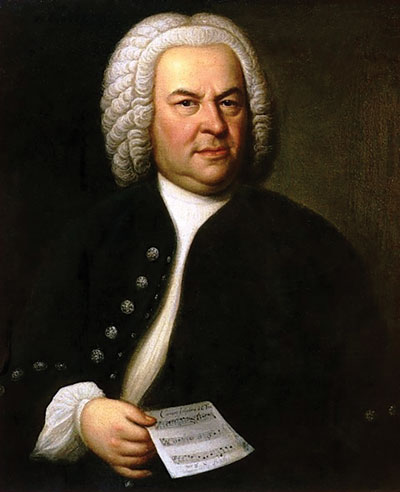Johann Sebastian Bach

- Born: March 21, 1685, Eisenach, Germany
- Died: July 28, 1750, Leipzig
Magnificat
- Composed: 1723, revised ca. 1730
- Premiere: Christmas Day 1723, Leipzig, under the composer’s direction
- Instrumentation: SATB chorus, SSATB soloists, 2 flutes, 2 oboes (incl. 2 oboes d’amore), bassoon, 3 trumpets, timpani, organ, strings
- CSO notable performances: First: May 1875, Theodore Thomas conducting, Theodore Thomas Orchestra (soloists: Helen Smith, soprano; Abbie Whinnery, soprano; Annie Louise Cary, contralto; William Winch, tenor; Myron Whitney, bass), Otto Singer, chorusmaster. Most Recent: May 2009, James Conlon conducting (soloists: Ellie Dehn, soprano; Jill Grove, mezzo-soprano; Rodrick Dixon, tenor; James Creswell, bass), Robert Porco, director of choruses. Most Recent CSO: November 2017, Louis Langrée conducting (soloists: Chloé Briot, mezzo-soprano; Leah Wool, mezzo-soprano; Meg Bragle, mezzo-soprano; Thomas Cooley, tenor; Matthew Brook, bass), Robert Porco, director of choruses.
- Duration: approx. 30 minutes
On June 1, 1723, Johann Sebastian Bach assumed the duties of Kantor for the churches of Leipzig. Although the city was something of a cultural backwater in the early 18th century, it was a powerful center of Lutheranism in Germany, and the position of music-master to its churches was a prestigious one. Bach, fully aware of the importance of his job, enthusiastically launched into his duties during his early years in Leipzig—most of his nearly 300 cantatas date from the first decade of his tenure. With only six months on the job, the 38-year-old composer made a special effort to impress his superiors with the music for his first Christmas season as Kantor, and he composed three new cantatas for the morning services of December 25, 26 and 27, as well as another for the New Year’s worship of the following week. In addition to these pieces (and playing the organ, and organizing the performers, and conducting the rehearsals, and copying the parts), he wrote his glorious Magnificat for the special afternoon Vespers service that was a beloved Leipzig Christmas-day tradition.
The text of the Magnificat is the Canticle of the Virgin Mary as given in the Gospel of St. Luke (1:46-55) and was a regular part of the Roman Catholic Vespers and Anglican Evensong services. Although usually sung in plainchant, these verses had prompted polyphonic compositions for special occasions since at least the 14th century. It was to enrich such important religious days that the Canticle was retained in the Lutheran Vespers services for Christmas, Easter and Pentecost. The Christmas Vespers in Leipzig began at 1:45 p.m., and included the formal order of worship, a cantata preceding the sermon, and the Magnificat as the brilliant finale to the day’s activities. Due to the imposing length of the Lutheran service in Bach’s time (often four hours in duration!), it was necessary that the closing items of the Vespers be succinct so that the Benediction would come before dusk. The compact nature of Bach’s 12 Magnificat movements demonstrates that he took this requirement to heart. The real reason for the local popularity of the Magnificat (besides its function of ending nearly eight hours of worship on Christmas day) was that it accompanied a tableau-vivant representation of the Nativity, with many of the Biblical characters portrayed by the church members in costume. For the original 1723 version of his Magnificat, Bach interspersed five German Christmas hymns among the Latin verses to accompany the stage action of this mystery play. (The durability of this spectacle in the affection of the Leipzigers is attested to by the fact that the City Council had tried unsuccessfully to abolish it since at least 1703.) In 1733, Bach revised the work by transposing it to its present key of D major and eliminating the Yuletide insertions, thereby making it practical for performance at Easter and Pentecost as well as at Christmas.
The esteemed English musicologist Sir Donald Tovey wrote, “Bach’s Magnificat is one of his most comprehensively representative works. From it, almost any point in Bach’s treatment of words, of musical forms, and of instrumentation can be brilliantly represented.” Each of the 12 movements engenders a clear and vivid mood: from the jubilant opening and closing choruses (which, by sharing the same joyous music, serve as supporting pillars for the entire structure) to the pathos of the duet Et Misericordia; from the surging power of Omnes Generationes to the bucolic sweetness of Esurientes Implevit Bonis; from the anguish of Deposuit Potentes to the confident optimism of the Doxology (Gloria Patri), Bach’s Magnificat is not just a beautiful work of art but also a document of the composer’s faith in the deity’s multifarious and omnipotent qualities. It is music that is joyous, festive and uplifting while being at the same time introspective and touching. Like his later B Minor Mass and St. Matthew Passion, Bach’s Magnificat scales the summit of the musical expression of man’s faith.
—Dr. Richard E. Rodda